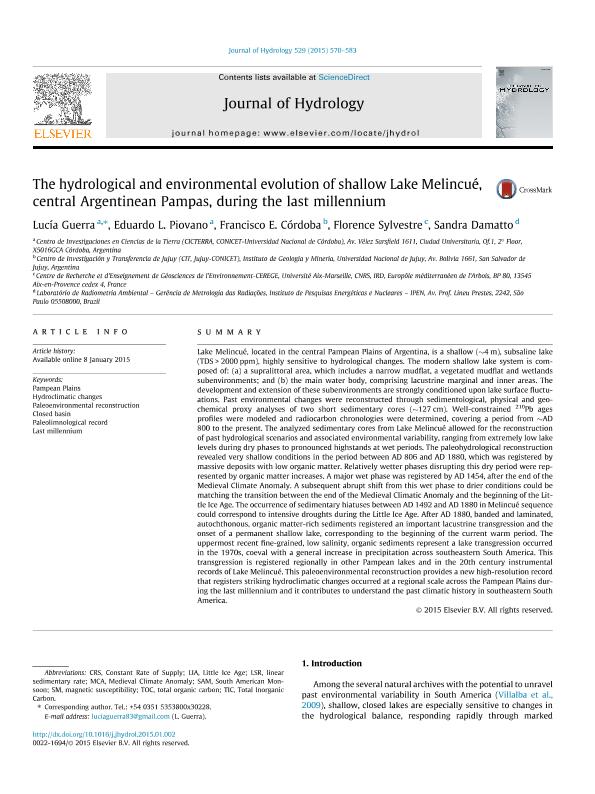Artículo
The hydrological and environmental evolution of shallow Lake Melincué, central Argentinean Pampas, during the last millennium
Guerra, Lucía ; Piovano, Eduardo Luis
; Piovano, Eduardo Luis ; Cordoba, Francisco Elizalde
; Cordoba, Francisco Elizalde ; Sylvestre, Florence; Damatto, Sandra
; Sylvestre, Florence; Damatto, Sandra
 ; Piovano, Eduardo Luis
; Piovano, Eduardo Luis ; Cordoba, Francisco Elizalde
; Cordoba, Francisco Elizalde ; Sylvestre, Florence; Damatto, Sandra
; Sylvestre, Florence; Damatto, Sandra
Fecha de publicación:
10/2015
Editorial:
Elsevier Science
Revista:
Journal Of Hydrology
ISSN:
0022-1694
Idioma:
Inglés
Tipo de recurso:
Artículo publicado
Clasificación temática:
Resumen
Lake Melincué, located in the central Pampean Plains of Argentina, is a shallow (~4m), subsaline lake (TDS>2000ppm), highly sensitive to hydrological changes. The modern shallow lake system is composed of: (a) a supralittoral area, which includes a narrow mudflat, a vegetated mudflat and wetlands subenvironments; and (b) the main water body, comprising lacustrine marginal and inner areas. The development and extension of these subenvironments are strongly conditioned upon lake surface fluctuations. Past environmental changes were reconstructed through sedimentological, physical and geochemical proxy analyses of two short sedimentary cores (~127cm). Well-constrained 210Pb ages profiles were modeled and radiocarbon chronologies were determined, covering a period from ~AD 800 to the present. The analyzed sedimentary cores from Lake Melincué allowed for the reconstruction of past hydrological scenarios and associated environmental variability, ranging from extremely low lake levels during dry phases to pronounced highstands at wet periods. The paleohydrological reconstruction revealed very shallow conditions in the period between AD 806 and AD 1880, which was registered by massive deposits with low organic matter. Relatively wetter phases disrupting this dry period were represented by organic matter increases. A major wet phase was registered by AD 1454, after the end of the Medieval Climate Anomaly. A subsequent abrupt shift from this wet phase to drier conditions could be matching the transition between the end of the Medieval Climatic Anomaly and the beginning of the Little Ice Age. The occurrence of sedimentary hiatuses between AD 1492 and AD 1880 in Melincué sequence could correspond to intensive droughts during the Little Ice Age. After AD 1880, banded and laminated, autochthonous, organic matter-rich sediments registered an important lacustrine transgression and the onset of a permanent shallow lake, corresponding to the beginning of the current warm period. The uppermost recent fine-grained, low salinity, organic sediments represent a lake transgression occurred in the 1970s, coeval with a general increase in precipitation across southeastern South America. This transgression is registered regionally in other Pampean lakes and in the 20th century instrumental records of Lake Melincué. This paleoenvironmental reconstruction provides a new high-resolution record that registers striking hydroclimatic changes occurred at a regional scale across the Pampean Plains during the last millennium and it contributes to understand the past climatic history in southeastern South America.
Archivos asociados
Licencia
Identificadores
Colecciones
Articulos(CICTERRA)
Articulos de CENTRO DE INVEST.EN CS.DE LA TIERRA
Articulos de CENTRO DE INVEST.EN CS.DE LA TIERRA
Citación
Guerra, Lucía; Piovano, Eduardo Luis; Cordoba, Francisco Elizalde; Sylvestre, Florence; Damatto, Sandra; The hydrological and environmental evolution of shallow Lake Melincué, central Argentinean Pampas, during the last millennium; Elsevier Science; Journal Of Hydrology; 529; P2; 10-2015; 570-583
Compartir
Altmétricas



